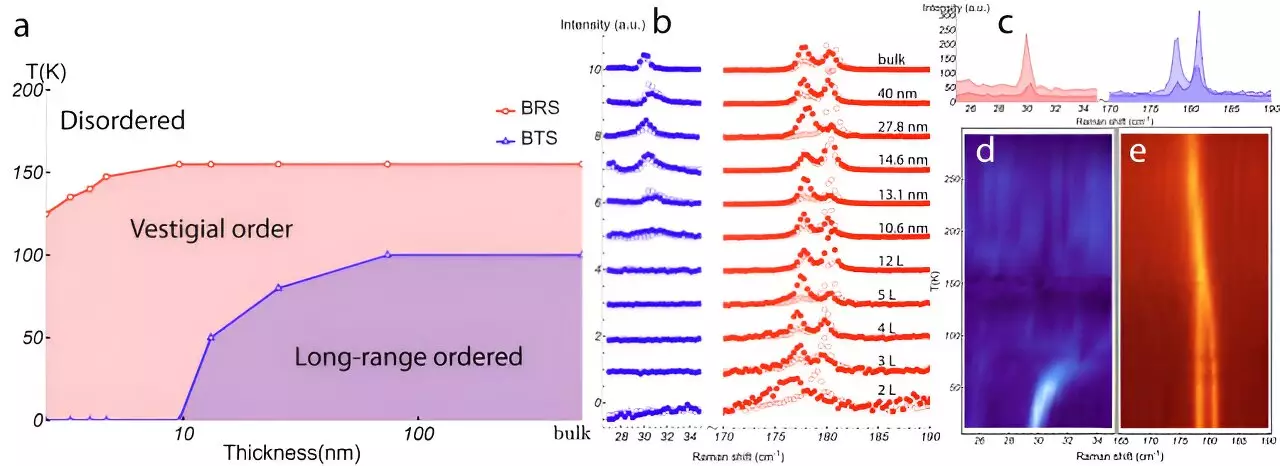In recent scientific advancements, a collaborative team of physicists from the University of Hong Kong, Texas Tech University, and the University of Michigan have made significant strides in understanding van der Waals (vdW) magnetic materials. Notably, their recent findings regarding nickel phosphorus trisulfide (NiPS3) reveal crucial insights into the magnetic behavior of these materials when manipulated at nanoscale dimensions. Such discoveries not only contribute to the field of condensed matter physics but also signal potential revolutionary applications in technologies ranging from electronics to energy storage systems.
The essence of the team’s research hinges on their experimental observation of a unique transition in NiPS3 from a three-dimensional (3D) long-range ordered state to a two-dimensional (2D) vestigial ordered state. This transition is particularly noteworthy because it sheds light on how the magnetic properties of materials can be extensively controlled through physical layering. By tweaking the material’s thickness, the researchers participated in a broader scientific dialogue regarding the manipulation of magnetic properties at the atomic level, fostering the potential for significant advancements in various technological applications, including high-density data storage and energy-efficient computing devices.
The groundbreaking nature of this study is underscored by its alignment with visionary ideas put forth by physicist Richard Feynman in his seminal 1959 lecture, “There’s Plenty of Room at the Bottom.” His foresight into the nanoscale manipulation of materials serves as a philosophical foundation for contemporary explorations into nanotechnology, specifically vdW materials, which promise a plethora of innovative applications.
To comprehend the complexities of NiPS3’s magnetic behaviors, one must delve into the physics of phase transitions. Central to this field is the concept of symmetry breaking—wherein changes in a material’s state can involve the loss of certain symmetrical properties, leading to new physical configurations. The research team captured these dynamics in NiPS3 through experimental techniques like nitrogen-vacancy (NV) spin relaxometry and optical Raman quasi-elastic scattering, providing a detailed view of how the material’s magnetic characteristics evolve during the transition.
This study introduced a unique phenomenon termed “vestigial order,” wherein specific characteristics remain constant even as primary order states collapse into simpler forms. Unlike traditional symmetry breaking, which erases multiple symmetrical features, vestigial order allows for the preservation of certain properties amidst the transition. The interplay between the primary and vestigial states observed in NiPS3 represents not only a critical scientific milestone but also a bridge to future exploration into how materials behave at reduced dimensionalities.
To augment the experimental findings, the researchers employed large-scale Monte Carlo simulations to visualize the magnetic phase transitions occurring in bilayer NiPS3. Such simulations serve as valuable tools in condensed matter physics, facilitating an understanding of complex interactions occurring at minute scales. These computational models assist in tracking the shifts in symmetry as dimensionality changes—a key aspect in comprehending the crossover from the original order to the vestigial order state.
The successful integration of simulation alongside experimental work marks a pivotal approach to the study of vdW materials, emphasizing the importance of interdisciplinary methodologies in unraveling the mysteries of these fascinating compounds. As such, this research not only deepens the understanding of 2D versus 3D physics but also propels the scientific community forward in unlocking the potential of layered materials.
As researchers proceed further in their exploration of materials like NiPS3 and multilayered graphene, the implications for future technology are vast. The promising properties of these materials—such as flexibility, transparency, and low power consumption—pave the way for the development of advanced planar electronic devices. This trajectory takes us closer to the realization of Feynman’s dream of engineered, multi-layered devices.
Consequently, the evolution from theoretical frameworks to practical implementations lays the groundwork for ultradense, low-power, flexible 2D logic and memory circuits, elevating the capabilities of modern electronics. Such advancements could lead to sustainable computing systems and contribute to energy-efficient technologies that address the increasing demands of contemporary society.
The recent discoveries pertaining to nickel phosphorus trisulfide stand as a testament to the transformational potential of van der Waals materials in modern science. By experimentally documenting the transition from long-range to vestigial ordered states and utilizing simulations to decode complex magnetic interactions, researchers are not only answering age-old questions posed by pioneers like Richard Feynman but also laying essential groundwork for future innovations in technology. As the field progresses, the excitement surrounding vdW materials continues to mount, promising a new era of electronic and computational advancements that could redefine the boundaries of material science.


Leave a Reply